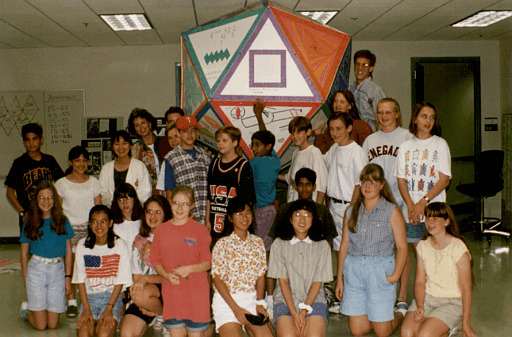Next: Conclusions
Up: Of Museums and Icosahedra
Prev: Mathematics on the Internet
Summer Enrichment
Through the World-Wide Web, the Geometry Center distributes
information to anyone who wants it. But the Geometry Center also runs
hands-on, in-house, summer enrichment programs in which we target
certain populations. This past summer our target populations were
6-8th grade females and underrepresented minorities, talented
undergraduates, and high-school math teachers.
Geometry, Graphics, and Grade-school
The 4-week summer program for 6-8 graders was a joint venture with the
Office of Special Projects in the University of Minnesota School of
Mathematics. The program was the culmination of a year-long effort to
provide exciting and enriching mathematics to students who are in the
process of making decisions about whether (or how much) mathematics
will play a part in their future. The curriculum for the summer course
was developed by postdocs at the Geometry Center and in the School of
Mathematics, and featured units on planar isometries, symmetry groups,
and the Platonic and Archimedean solids. The last two weeks of the
summer institute focused on geometry and visualization, and made
extensive use of the Geometry Center. The students met at the Geometry
Center to use the Center's facilities and Center-produced software. As
a closing group project of the solids unit, the students constructed
what we believe to be the
world's largest paper model of the MAA
symbol---a six-foot high icosahedron.

Figure 2: The summer enrichment class poses
with their creation: an icosahedron of staggering proportions!
This construction was motivated by a FOCUS article (February,
1994) that showed a group of elementary school students who had built
the world's largest rhombicosidodecahedron. In that polyhedron, each
side had a length of 13 inches. Rather than try to better that
record, we chose to construct an icosahedron of roughly the same size;
this resulted in our icosahedron having edges that measure 37
inches. The event attracted the attention of the local television
stations and newspapers who not only covered the event but also
interviewed the beaming students. Weeks later, the icosahedron was
prominently displayed at the MAA booth at Mathfest, the joint summer
meeting of the MAA and the AMS. We hope to encourage more students to
explore symmetry and solid geometry by building models;
a teacher's
guide to creating a large icosahedron as a class project is available
on-line from the Geometry Center's WWW server.
Undergraduate Research Experience
A much longer and more intensive summer program is the Geometry
Center's research experience for undergraduates. We invite 20
undergraduates to spend 10 weeks at the Geometry Center conducting
research in topics chosen from mathematics, computer science, and math
education. They work under the supervision of their ``coach'' Tony
Phillips from SUNY Stony Brook, and collaborate on projects with
Center postdocs, University math professors, and representatives from
industry. This year many of the students presented their results at a
poster session during Mathfest, and several will also be traveling to
an upcoming AMS meeting to present their work. The students tackled
difficult problems in celestial mechanics, dynamical systems,
Riemannian manifolds, and mathematical biology. The products of their
labors include software and videos to illustrate the problems and
solutions. One student, who began teaching high school mathematics
this fall, even produced a computer-animated video designed to
introduce high school students and teachers to non-Euclidean geometry!
She completed this sophisticated video in just 10 weeks (thanks to the
support of the Geometry Center staff) and the result was so
impressive that a publisher wants to market her video.

Figure 3: A sample frame from Lori Holthus'
video that introduces high school teachers and students to
non-Euclidean geometry.
Teaching the Teachers
In addition to our summer program for undergraduates, the Geometry
Center also annually runs an intensive two-week residential summer
course for high school teachers of mathematics. The programs
introduce new mathematics to the teachers and encourages them
teachers to develop activities suitable to use in their classrooms.
This year the program on probability and statistics was called CHANCE
and analyzed current events as reported in newspapers and journals.
For example, the teachers discussed and debated applications of
statistics to DNA fingerprinting and questioned whether vitamin
supplements have any significant impact on health. The course
participants learned that seemingly significant events (such as
winning and losing streaks in sports) may actually be the natural
outcomes of random events.
Information about the CHANCE project,
including a complete set of handouts from the summer course is
available from the Geometry Center's WWW server.
Next: Conclusions
Next: Conclusions
Up: Of Museums and Icosahedra
Prev: Mathematics on the Internet
![[HOME]](/pix/home.gif) The Geometry Center Home Page
The Geometry Center Home Page
Author: Frederick J. Wicklin <fjw@geom.umn.edu>
Comments to:
webmaster@www.geom.uiuc.edu
Created: September 26, 1994 ---
Last modified: Jul 21 1996
![[HOME]](/pix/home.gif) The Geometry Center Home Page
The Geometry Center Home Page

![[HOME]](/pix/home.gif) The Geometry Center Home Page
The Geometry Center Home Page